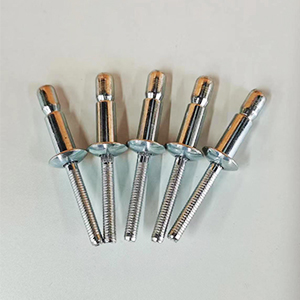Rivets are parts that use their own deformation or interference to connect the riveted parts in riveting. There are many types of rivets, the common ones are dome head, round head, countersunk head rivets, blind rivets and hollow rivets, which are usually connected by their own deformation. The parts to be riveted. (Generally, cold riveting is used below 8mm, and hot riveting is used above 8mm). But there are exceptions. For example, the factory nameplate on the 3-ring lock is riveted by the interference between the rivet and the lock core hole. The rivet insertion is very unique. It is divided into two parts. There is a hole in the middle of the management of the thicker part of the rod body with the cap, which is in transition with the thinner part of the rod body with the cap. When riveting, just drive the thin rod into the thick rod. The following is a brief introduction Let's take a look at the role of different rivets.
Half round rivets are mainly used in riveting occasions with large lateral load, and are widely used. Flat head rivets are corrosion-resistant due to their thick heads, and are often used in riveting occasions with strong corrosiveness such as ship hulls and boiler water tanks. Countersunk head and 120 degree Countersunk head rivets are mainly used for riveting occasions with smooth surface and small load. Semi-countersunk head rivets and 120-degree semi-countersunk head rivets are mainly used for riveting occasions with smooth surface and small load. Flat head rivets and flat round head rivets are mainly used for leather, Canvas, wood and other metal plates or non-metallic materials for riveting occasions. Flat head rivets are mainly used for riveting occasions of non-metallic materials; semi-hollow rivets are mainly used for riveting occasions with small load; headless rivets are mainly used for riveting of non-metallic materials Occasion; hollow rivets are light in weight and weak in head, and are used for riveting of non-metallic materials with small loads. Tubular rivets are used for riveting non-metallic materials without load.
The identification plate rivet is the key to riveting the factory nameplate on the equipment and mechanical equipment. The blind rivet is a kind of rivet used for single and double riveting, but it must be riveted with a common tool - riveting gun (manual, electric, automatic) .This comparison is suitable for riveting occasions where it is more troublesome to choose general rivets (riveting must be carried out from two sides), so it is widely used in engineering construction, automobiles, ships, airports, equipment, household appliances, furniture and other commodities. Among them, the opening flat Round head blind rivets are widely used, countersunk head blind rivets are suitable for riveting occasions where the main performance must be smooth, closed blind rivets are suitable for riveting occasions with large loads and certain sealing characteristics. Face and double-sided riveted rivets. When riveting, hammer the core exposed at the top of the rivet head to make it flush with the inner hole of the rivet head, that is, the actual riveting operation is quite convenient, suitable for selecting general-purpose rivets (riveting must be done from two sides Riveting occasions where it is more troublesome to carry out) or blind rivets (lack of riveting gun).

Related News
- Types of wire drawing rivets and anti-rust methods
- How to use blind rivets
- What is a rivet nut?
- Structure introduction and maintenance of rivet gun
- Application of Lantern Rivet Nut
- Classification and application of rivet standoffs
- The working principle and selection rules of riveting gun
- The use of rivet nuts
- Comparison of drawing rivet connection and traditional craftsmanship
- How to use blind rivets
- Precautions when using blind rivets



